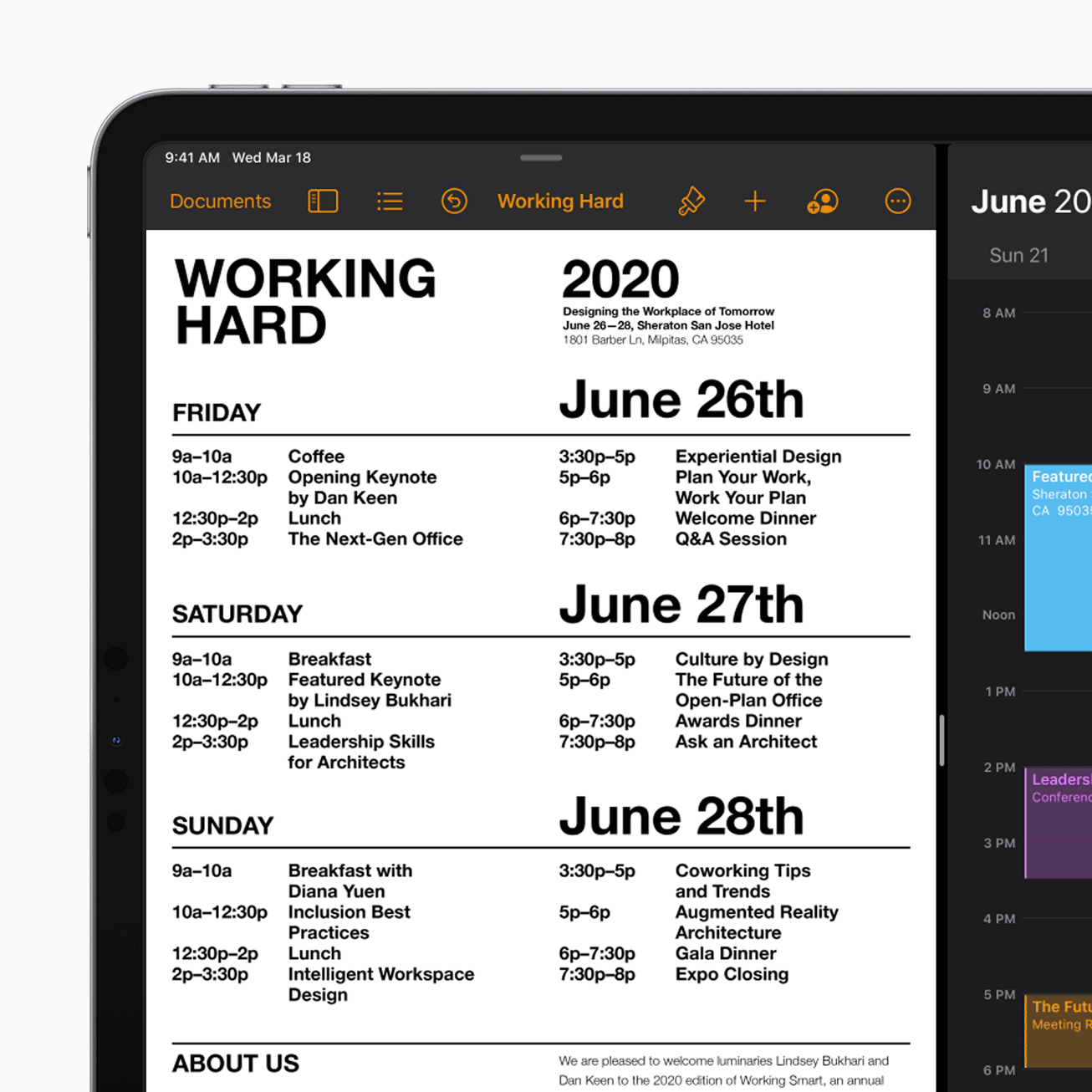You can see the problem I have created for myself; I’m asking for something with a keyboard big enough for fluid typing and the processing grunt to handle images and audio (and associated plugins). Basically, a regular, decent-spec laptop. But there are multiple options in the small laptop space, so it can’t be totally unreasonable? The Pocket 2 from GPD ($500), for example, clearly claims to offer both power and portability. Then there’s the 7-inch Peakago ($399) that mimics the Lenovo Yoga Book series in a much smaller form. These are just two examples I’ve tried recently, along with others in the past and, well, let’s just say the search continues.
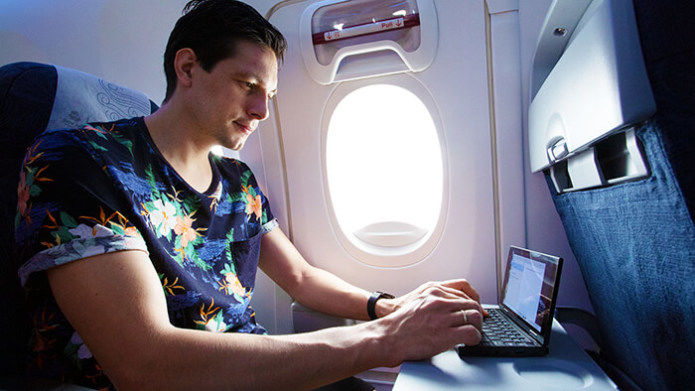
You might know GPD for its gaming-focused (and equally diminutive) portables. If you’re looking for a handheld device for PC gaming, it offers several options, often with buttons and a D-pad built-in. It’s logical, then, that the company figured it could strip out the gamepad and have a solution for mid-to-pro level users. And given that the product page for the Pocket 2 proudly states “Technology rivals the MacBook,” I was pretty optimistic. After all, I write on a MacBook every day and use one for music production in my spare time.
What GPD didn’t clarify, is which MacBook its technology rivals. Given that the Pocket 2 runs a low-power Intel (3965Y) processor that’s dual-core and 1.5GHz, it must have been a pretty old one. The company also claims “[The] GPD Pocket 2 uses the same Intel 3965Y processor as the new Surface Pro.” This is… not true. Both the Pocket 2 and the Surface Pro use chips based on Kaby Lake architecture, but that’s about all they have in common. (To be fair, it’s also possible the website just needs updating as the spec might have changed since then.) The Pocket 2 runs a Celeron, while the (cheapest) Surface Pro has an m3 chip. In lay terms, the Celeron isn’t a bad processor for mobile gadgets, but the m3 series is designed for more premium ultraportables, and has extra threads to deal with their generally higher performance requirements.
Generous comparisons aside, the Pocket 2 does meet most of my requirements on paper. As the name suggests, it will fit in my (back) pocket, and the processor should be just enough to do what I want it to. With 8GB of RAM and 256GB of storage (besting what you’d get on a $900 Dell XPS 13), it’s a fairly well-rounded machine, and it’s not like I want it to be my main computer, this is for whiling away time on flights and in coffee shops. It even has a few things my MacBook doesn’t: A touchscreen, full-sized USB ports (plus one USB-C) and a MicroSD slot.
There’s at least one area where the Pocket 2 is similar to a MacBook, and that’s its design. Thanks to the all-metal exterior, tapered edge and familiar color, it looks like someone took a MacBook Air and shrunk it down to a shade over 7-inches (the display size of the Pocket 2).
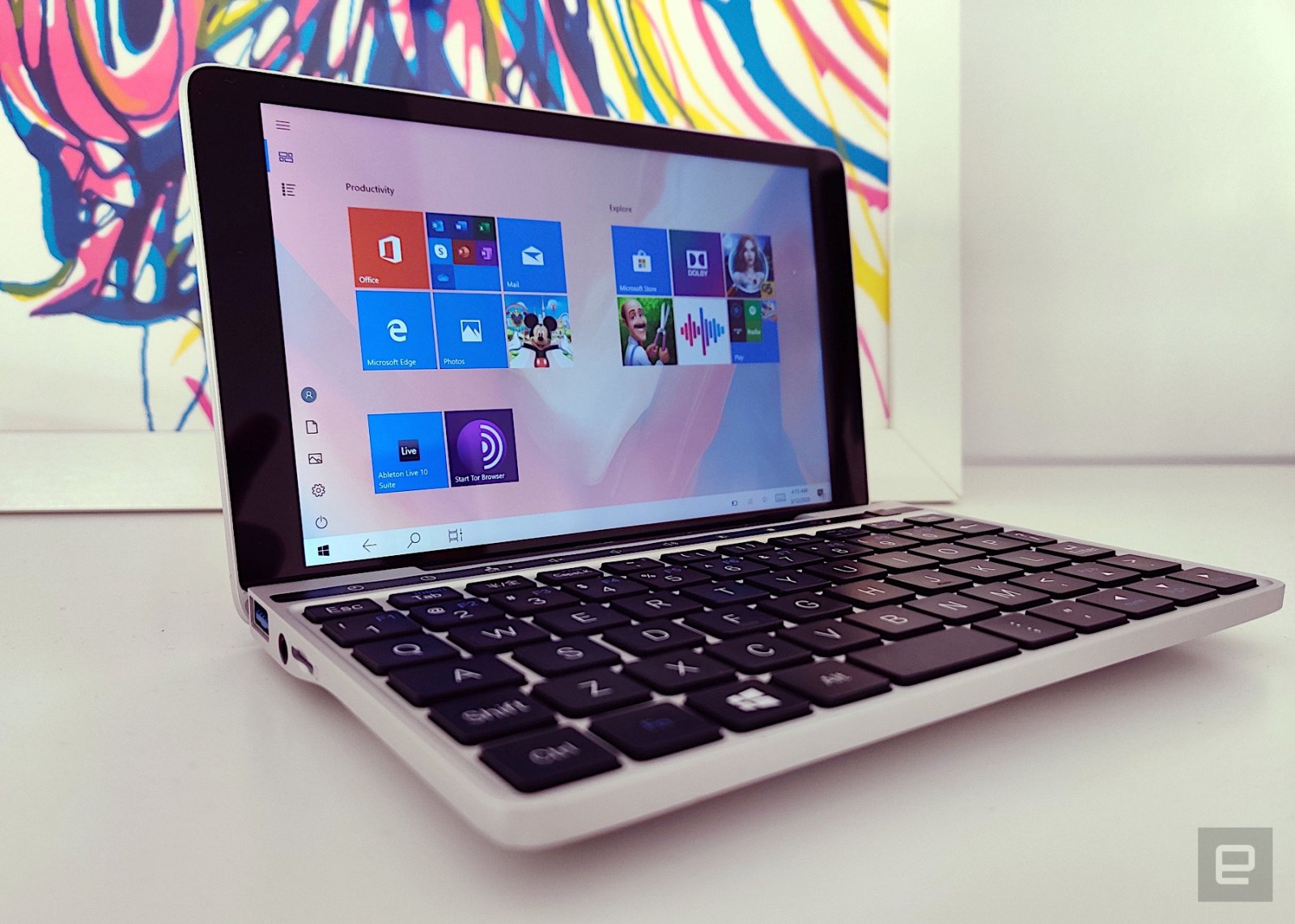
As for the Peakago, it’s a much more lightweight affair. Like the Pocket 2 it has a 7-inch, 1920 x 1200 (WUXGA) IPS display but otherwise, it’s pretty different inside. You have a choice of either 64GB or 128GB storage options, and either 4GB or 8GB of RAM. Port-wise it’s similar to the Pocket 2, just with the addition of a Micro HDMI, and there’s a front-facing camera (albeit it a meager 0.3-megapixels) too. Running the show, however, is a Pentium N4200 — a less capable bit of silicon.
Peakago offers fewer superlative claims about its laptop, but the makers still couldn’t resist one MacBook comparison — weight. At around 540g, it is, as claimed, roughly half the heft of Apple’s laptops, though a shade heavier than the Pocket 2 (510g). Unsurprisingly, given the Peakago folds over into tablet mode, there’s also a touchscreen.
Writing
Typing is something I do a lot. And it’s the first thing to be sacrificed on a diminutive device. When I reviewed the Gemini from Planet Computers, I had tempered my expectations about being able to touch type, and those low expectations were met. You can peck out emails or even thumb-type with some success, but I could never even come close to touch typing on it. It’s not just the size of the keys that tends to be the issue, it’s also how they’re laid out to compensate for the diminished real estate. That Enter key, tab or space bar will likely be in a slightly weird position compared to what you’re used to. Not to mention things like comma, quotes and the @ symbol.
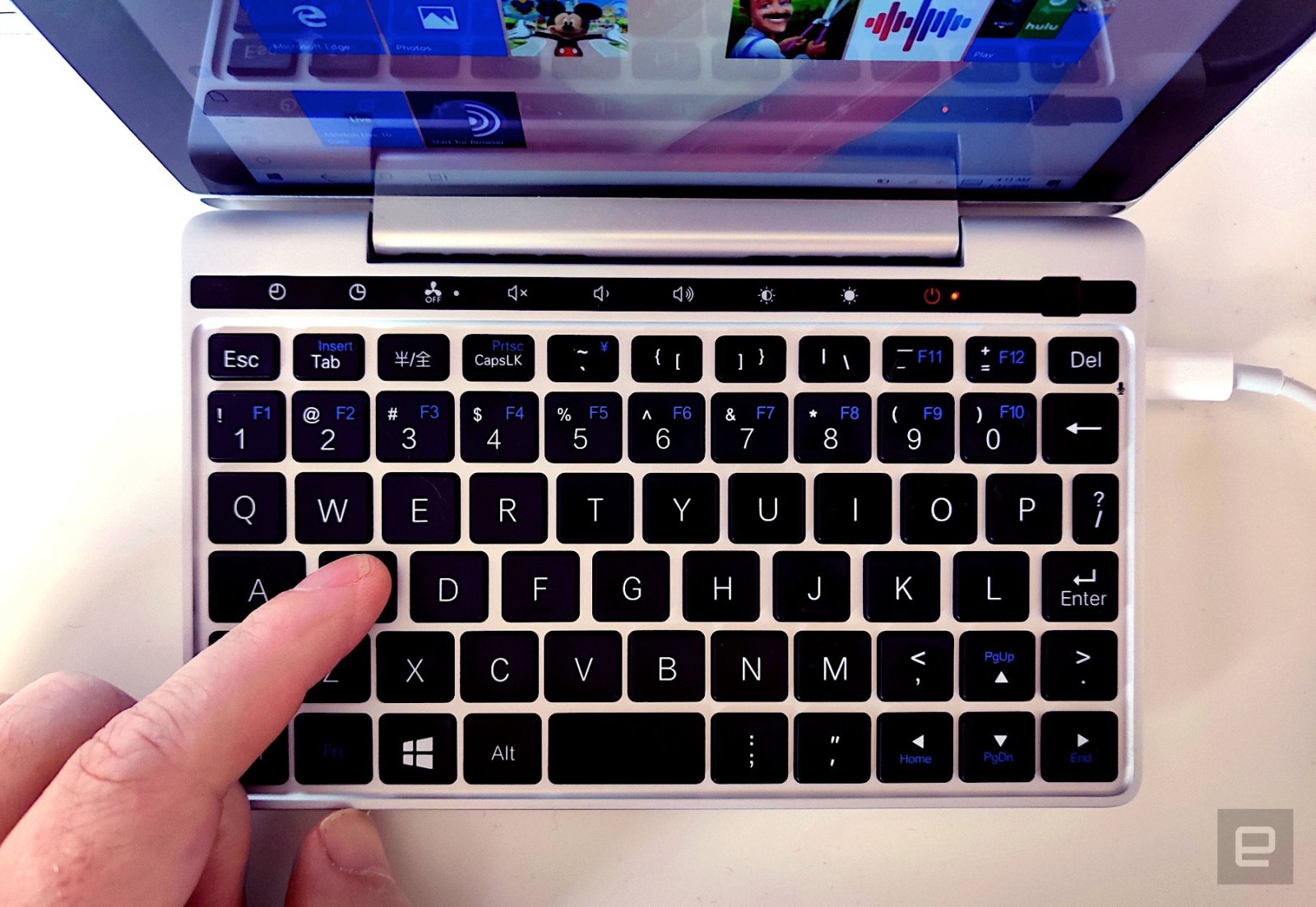
The Pocket 2 and Peakago are about twice the size of the Gemini though, so I held out hope that they might be easier to type on. I was wrong. Quite badly wrong. Initially, I put this down to muscle memory (or lack of it). But I’ve persisted and my ability to type has barely improved on either. I’m a fairly competent typer, not lightning-fast, but according to a quick online test, I average about 65 words a minute — on a regular keyboard at least. With these smaller laptops, this plummeted to around 16. My typing style and physiology might be contributing factors, but most likely all typing styles will take a hit.
It’s not just how many words either; accuracy is important too. Below are two versions of the same phrase. The top one is typed on a full-sized keyboard, while the lower one was typed on the Pocket 2. Both are presented as typed, with no corrections.
“The quick brown fox jumped over tha lazy dog.”
“The wquick brownb fox hjumoprfed over the kslazydog”
As you can see, the difference is stark. This also means constant deleting, editing and going back, which itself introduces more keystrokes — some of which will be wrong. If you held a gun to my head and asked me to only ever write on one of these machines, I’d go with the Peakago. Its keyboard feels slightly better organized and the size of the space bar (and position of other special keys) on the Pocket 2 doesn’t help.
Music
To run a full-blown music-making app (in my case, Ableton Live) seems like the much bigger ask of such machines. Surprisingly, this is where things actually went a little better. Most mini-laptops, PDAs and tablets at this size or price just won’t run a desktop app like this. Often, because they don’t run any (as they’re Android, iOS or some other mobile operating system). The Pocket 2 runs full-fat Windows 10, though, while the Peakago runs Windows 10 in S mode but can easily be switched to “full” windows. I’ve run Ableton Live on some pretty old and creaking machines, so I had hope.
Ableton’s website claims the minimum specification for Live is:
Windows 7, Windows 8 or Windows 10
64-bit Intel (Intel Core™ i5 processor or faster recommended) or AMD multi-core processor
4 GB RAM (8 GB or more recommended)
That’s vague enough — what if I had an 11-year-old AMD Athlon? — that I was optimistic it might at least work for what I wanted. I don’t expect to be able to have a desktop experience, running several processor-intensive plugins, or for everything to be smooth and lag-free. I just want to be able to noodle with ideas that I can transfer to the desktop later. I am aware there are multitude iPad apps for music-making on the go, but I’ve never really warmed to them, and I know Live pretty well so prefer to keep within the one app.
To my surprise, Ableton Live runs well on the Pocket 2 (relatively speaking), and moderately well on the Peakago. There are caveats of course. I only installed one VST instrument (plugin) for starters — on the desktop I have many, many more and often run numerous ones at the same time. But with just my favorite synth installed, I was able to run multiple instances over several tracks without much effort.
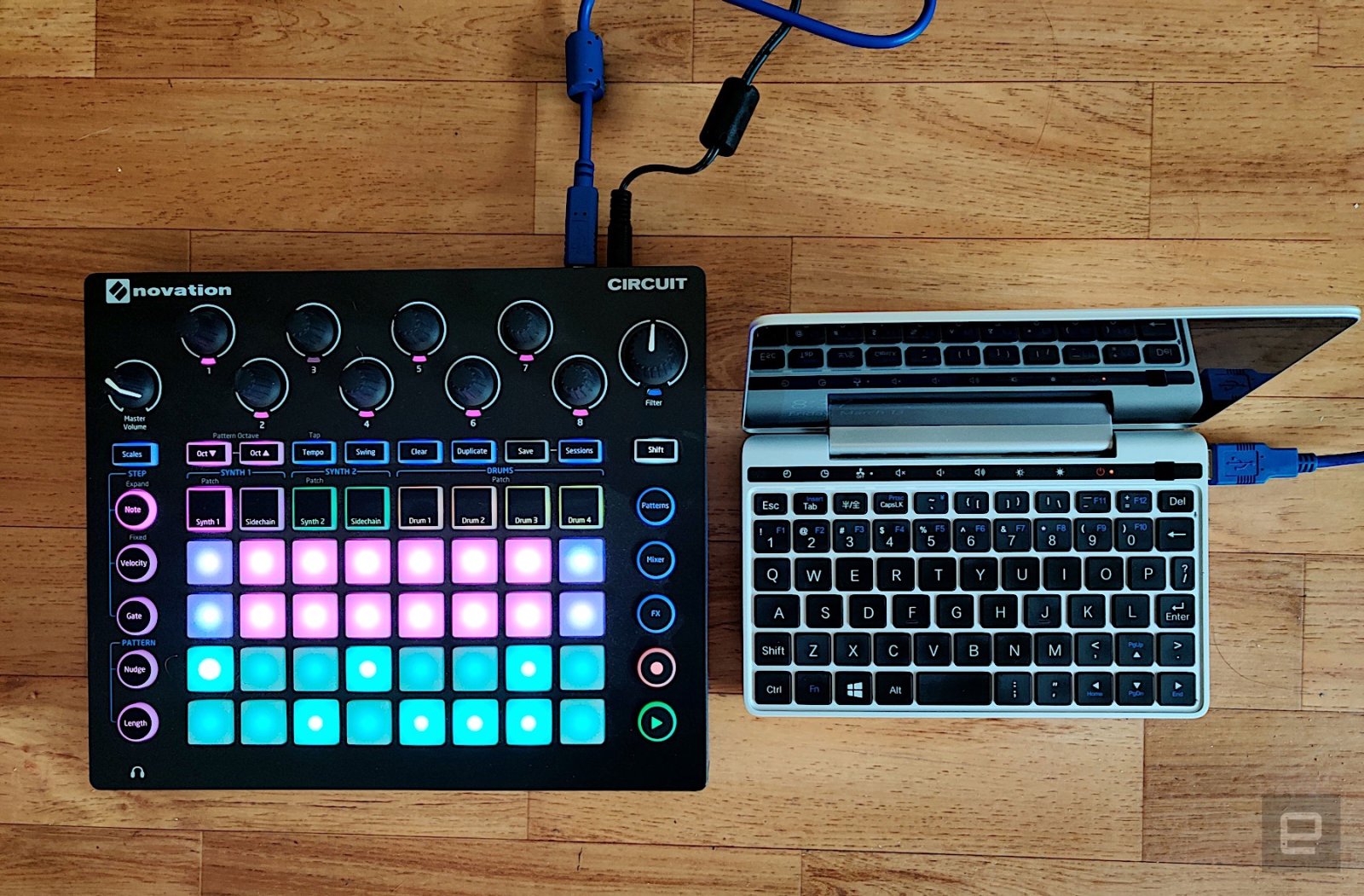
The bigger issue is that the small screens make the Live interface pretty cramped. You can still access everything that you would on the desktop, but you might have to make sacrifices. For instance, I like to have most of the mixer and audio-routing controls showing at all times (these are placed at the bottom of each piece of audio/MIDI in columns), but on these smaller laptops this is basically impossible, so you’ll have to activate and deactivate each one as you need it. Even doing that isn’t as easy as I’d like. The Pocket 2 and Peakago don’t have touchpads, instead there’s an optical mouse “nubbin” — top right of the keyboard on the Pocket 2, center front by the space bar on the Peakago. I am not a fan.
The optical mice work fine for general navigation of Windows or a browser, but even then it’s frustrating. I often found myself overshooting the thing I wanted to click on. You can click the nubbin, like you would a mouse, but if you want to click-and-hold (say, with a scroll bar), you’ll need to use the dedicated left and right mouse buttons. These are separate keys on the left-hand side of the function keys on the Pocket 2; on the Peakago they’re more conveniently placed either side of the optical mouse below the space bar.
Fortunately, as I mentioned earlier, both have touch screens and Windows 10 has “tablet” mode. Between these two things, you can poke and swipe your way around most apps, Ableton Live included. You’ll still need to swap back to the mouse nubbin every so often, but it’s workable.
Most (reasonable) people probably wouldn’t expect a tiny laptop to ever perform like a full-sized one. And technically, I don’t either. Like I say, I’ve run Ableton on some pretty old machines that were “good” in their day. I guess I’m hoping an ultra-portable today can equal “premium” from the past. Just how far back in the past is a fairly difficult question to answer.
If I had to pick between the two for running something more CPU-intensive like Ableton Live, I’d go with the Pocket 2. It just ran more fluidly and felt more similar to working on a regular laptop — albeit only just. The Peakago made a noble attempt, and it does kinda function, but nowhere near enough that you would want to persist with it.
Hard truths
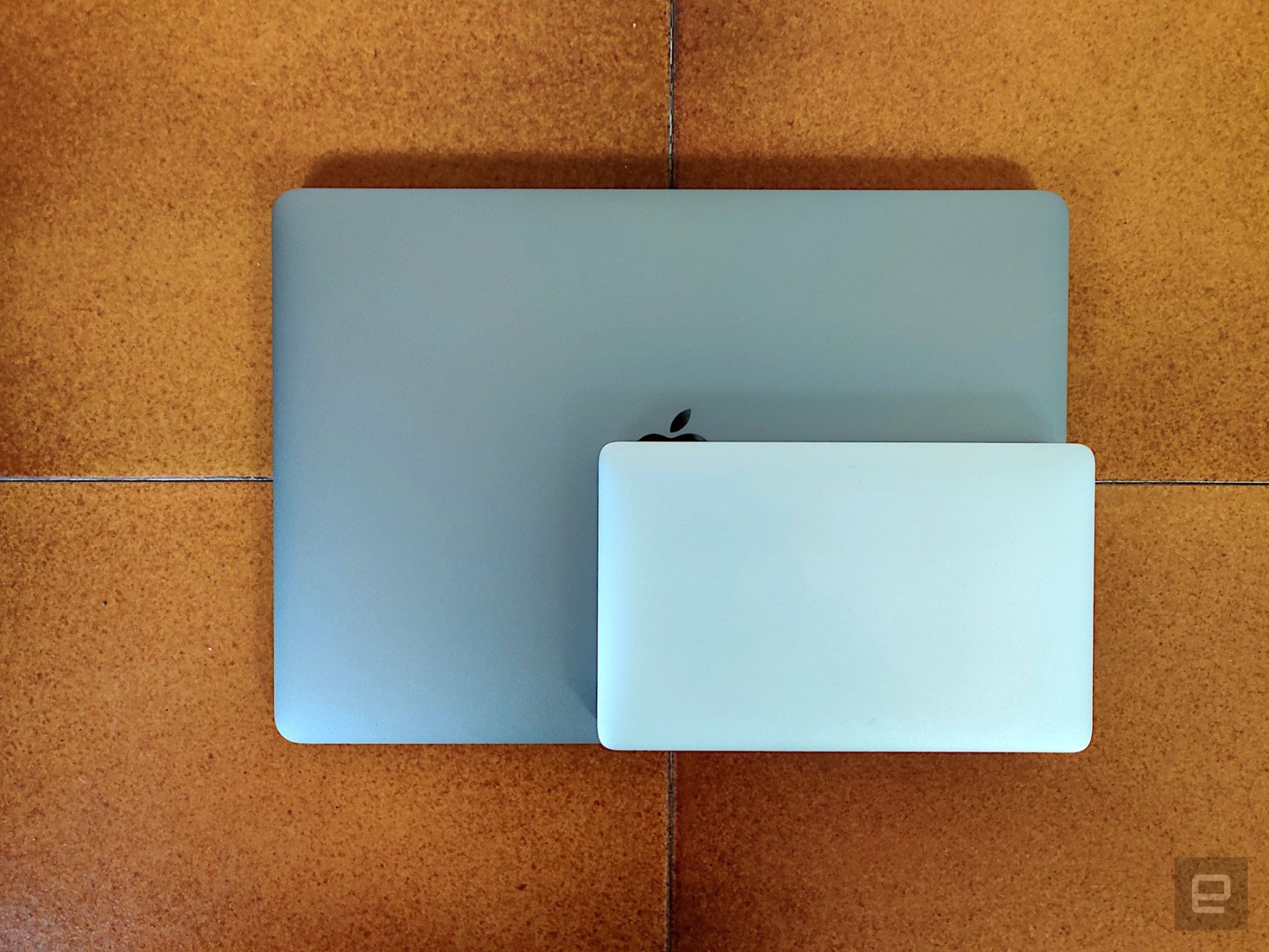
Ignoring my ambitious expectations, mini laptops presumably exist for a reason. One assumes that there are enough people out there that want a full-featured operating system on a machine that won’t weigh them down. People that have the dexterity to type on them that I do not. In that regard, the Pocket 2 and the Peakago have a lot to offer. Windows 10 runs just fine on both for most daily tasks (multiple tabs open in Chrome, watching HD YouTube videos etc.) and if you can get your head (fingers?) around the keyboards you can probably get some work done. The problem isn’t with these specific laptops; every tiny “PC” I’ve used suffers the same challenges.
There are, of course, multiple ways to compute on the go. Apple and Microsoft have their own solutions (the iPad with a keyboard is pretty nifty, and the Surface Go has several fans). For me, the iPad would work for writing and other general tasks but obviously wouldn’t support some of the full desktop apps I desire. The Surface Go is a viable option (with a keyboard case) and hovers around the same price as the two laptops here, but I’d be breaking my own “pocketable” rule as its 10-inch display puts it nearer to regular notebook territory.
I still hold out hope that there’s a viable solution. The Pocket 2 comes tantalizingly close, at least at a performance level. Then there’s the forthcoming Surface Neo, which might just be the right balance of size and power. And while there may be some other exotic combination out there, I fear at least part of my dream is simply thwarted by physics/physiology.






